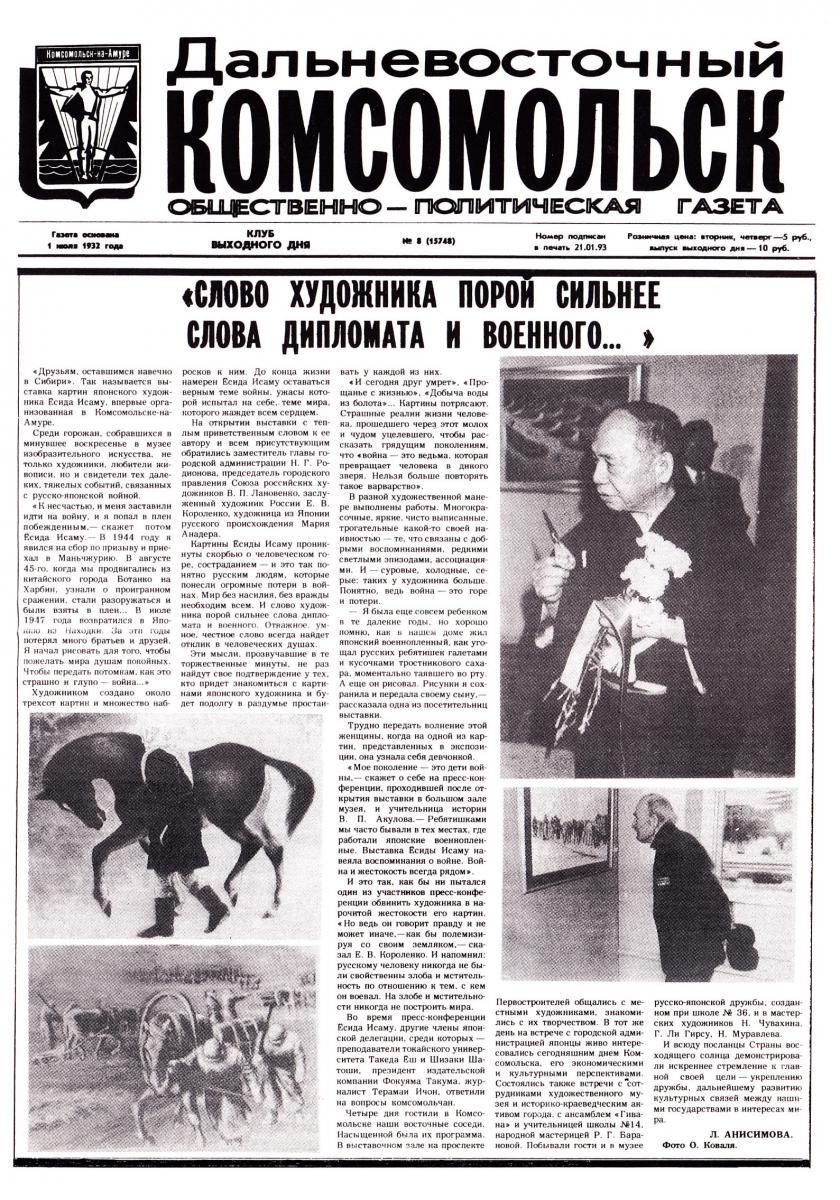Dal’nevostochniy Komsomolets ( Far East Komsomol Member)
Public Political Newspaper #8(15,748)
Weekend Club
January 21, 1993
Price Tuesday-Thursday 5 rubles, weekend 10 rubles
“The Words of the Artist is Sometimes Stronger than the Words of a Diplomat or a General…”
"To friends, forever remaining in Siberia. " This is the name of the exhibition of paintings of the Japanese artist Isamu Yoshida, the first time organized in Komsomolsk-nа- Amure. Among the townspeople gathered last Sunday in the Museum of Fine Arts, not only artists, lovers of painting, but also witnesses of now distant, heavy events related to the Russian-Japanese war. "Unfortunately, I was forced to go to war, and I got in-prisoned, defeated, ”says Isamu Yoshida. “In 1944 I was on conscription call and came to Manchuria. In August of 1945, when we moved from the Chinese city Mudanjiang to Harbin, we learned about the lost battle, began to disarm and were taken as prisoners… In July of 1947 I returned to Japan from Nachodka. Over these years I lost a lot of brothers and friends. I started my drawing as a wish for peace for the perished souls. To pass the message to the descendants about how horrible and foolish war is…”
There are about 300 paintings created by the artist, and numerous sketches related to them. Until the end of his life, Isamu Yoshida intends to remain faithful to the theme of war, the horrors of which he experienced himself, to the theme of peace, which he longs for with all his heart. At the opening of the exhibition, Deputy Head of the City Administration N.G. Rodionova, Chairman of the City Board of the Union of Russian Artists V.P. Lanovenko, Honored Artist of Russia E.V. Korolenko, and artist from Japan of Russian descent Maria Anadera addressed the author and all those present with a warm welcome speech. Isamu Yoshida 's paintings are imbued with care for human grief, compassion - and this is so understandable to the Russian people who have suffered huge losses in war. A world without violence, without enmity is vital for everyone. And the word of the artist is sometimes stronger than the word of a diplomat or a military man.
A brave, smart, honest word will always find a response in human souls. These thoughts, voiced in those solemn moments, will more than once find their confirmation among those who come to get acquainted with the paintings of the Japanese artist and will create a long lasting meditative experience for those who will spend a long time near each of these paintings.
“And today a friend will die”, “Farewell to life”, “Water extraction from the swamp” ... The pictures are stunning. The terrible realities of the life of a person who went through this horror and miraculously survived to tell future generations that “war is a witch who turns a person into a wild beast. Such barbarity can no longer be repeated. " The works were done in a different artistic manner. Multicolored, bright, purely expressed, touching with some kind of naivety - those that are associated with good memories, rare bright episodes, associations. And - harsh, cold, gray: the artist has more of them. It is clear, because war is grief and loss.
“I was still quite a child in those distant years, but I well remember how a Japanese prisoner of war lived in our house, how he treated Russian children to biscuits and pieces of cane sugar, which instantly melted in my mouth. And he also painted. I saved the drawings and gave them to my son,” - said one of the visitors of the exhibition. It is difficult to convey the excitement of this woman when, in one of the paintings on display, she recognized herself as a girl.
“My generation is the children of war,” the history teacher V.P. Akulova will say about herself at the press conference held after the opening of the exhibition in the large hall of the museum. “As children, we often visited the places where Japanese prisoners of war worked ... Isamu Yoshida's exhibition evoked memories of the war. War and cruelty are always there." And this is so, even though one of the participants in the press conference tried to accuse the artist of “the deliberate cruelty " of his paintings." “But he speaks the truth and cannot do otherwise,”E. V. Korolenko, as if arguing with his fellow countryman, said. The Russian people have never been characterized by malice and vengefulness towards those with whom they fought. Peace can never be built on malice and vindictiveness.
During a press conference, Isamu Yoshida, other members of the Japanese delegation, including teachers of Tokyo University Ieshi Takeda and Satoshi Shizaki - the president of the publishing company Takuma Fokuyama, journalist Ichro Teramai, answered the questions of the Komsomolsk citizens. Our eastern neighbors stayed in Komsomolsk for four days.
Their program was intense. In the exhibition hall located on the Pervostroitelei (first builders) Avenue they communicated with local artists and got acquainted with their work. On the same day, at a meeting with the city administration, the Japanese guests were keenly interested in the present day of Komsomolsk, its economic and cultural prospects. Meetings were also held with the staff of the art museum and the historical and local core activists of the city, with the ensemble "Givana" and the teacher of School Number 14, folk craftswoman R.G. Baranova.
The guests also visited the Museum of Russian-Japanese Friendship, created at School Number 36, as well as artist’s workshops of N. Chuvakhin. G. Lee Girsu and N. Muravleva. And everywhere the envoys of the Land of the Rising Sun demonstrated a sincere desire for their main goal - strengthening friendship, further developing the cultural ties between our states in the interest of peace.
Written by L. ANISIMOVA.
Photo by O. Koval.
Translation of Russian to English by Igor Veligan

